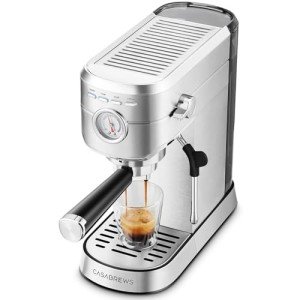The Ultimate Guide to Cappuccino Machines: Brewing the Perfect Cup
Coffees are a precious coffee drink that combines the rich tastes of espresso with steamed milk and milk foam. For lots of, nothing tastes better than a homemade cappuccino crafted with precision. Nevertheless, reproducing the ability of a barista in your home requires the best devices. This is where cappuccino machines enter play. This article explores the various kinds of cappuccino machines, how they work, and pointers for picking the very best one for your requirements.
What is a Cappuccino Machine?
A cappuccino machine is a customized brewing gadget created to make cappuccinos and other espresso-based drinks. These machines generally feature an integrated espresso maker, a milk frother, and different controls for adjusting temperature and pressure. Cappuccino machines can be manual, semi-automatic, or totally automatic, offering various levels of user control depending on the complexity of the machine.
Types of Cappuccino Machines
1. Manual Espresso Machines
- Description: These machines need users to operate most functions manually, including grinding coffee beans, tamping the grounds, pulling the espresso shot, and frothing the milk.
- Pros:
- Offers total control over the developing procedure.
- Can produce high-quality, café-like espresso.
- Cons:
- Steeper learning curve.
- Requires more time and effort.
2. Semi-Automatic Espresso Machines
- Description: Semi-automatic machines automate some processes, such as water pressure. Users still need to grind coffee and froth milk by hand.
- Pros:
- Balanced control and convenience.
- Permits space for experimentation.
- Cons:
- Still requires useful abilities.
- Can be intricate for novices.
3. Totally Automatic Espresso Machines
- Description: These machines automate the whole brewing process, from grinding to frothing. Professional Espresso Machines select the desired beverage.
- Pros:
- Extremely convenient and easy to use.
- Constant outcomes with little effort.
- Cons:
- More expensive.
- Restricted control over the brewing process.
4. Super Automatic Espresso Machines
- Description: Similar to totally automatic machines, but these designs include features like an integrated milk frother and grinder. They prepare drinks with simply the touch of a button.
- Pros:
- Ultimate benefit; makes numerous beverages rapidly.
- Built-in cleansing and upkeep features.
- Cons:
- High initial cost.
- Less hands-on experience with coffee making.
Key Features to Consider
When picking a cappuccino machine, several features can significantly influence efficiency and user experience. Here are some vital elements to evaluate:
1. Build Quality
- Materials used (stainless steel, plastic)
- Durability and longevity
2. Capability
- Water reservoir size
- Bean hopper capacity
3. Frothing Capability
- Kind of frothing wand (manual, automatic)
- Steam pressure and temperature control
4. Relieve of Use
- User-friendly controls
- Cleaning up and upkeep requirements
5. Price
- Variety from budget to high-end designs
- Consider service warranties and client support choices
6. Brand name Reputation
- User reviews and expert viewpoints
- Availability of replacement parts
The Brewing Process
To brew the perfect cappuccino in your home, follow this procedure, no matter the machine type:
- Prepare the Espresso: Use newly ground coffee beans and pull a double shot (approximately 2 ounces) of espresso.
- Froth the Milk: Steam fresh milk to a temperature level about 150 ° F( 65 ° C)using the steam wand or automatic frother.
- Combine: Pour the steamed milk over the espresso, followed by a layer of milk foam (equivalent parts espresso and steamed milk, with about 1 cm of foam).
For a graph, here's a simple table comparing the characteristics of the cappuccino machine types:
| Machine Type | Control Level | Ease of Use | Cost Range | Perfect For |
|---|---|---|---|---|
| Manual Espresso Machine | High | Tough | Low to Medium | Coffee enthusiasts, perfectionists |
| Semi-Automatic Machine | Medium | Moderate | Medium | Home baristas, hobbyists |
| Totally Automatic Machine | Low | Easy | Medium to High | Casual drinkers |
| Super Automatic Machine | Very Low | Very Easy | High | Hectic experts |
Frequently Asked Questions (FAQs)
What is the very best milk to use for coffees?
Whole milk is commonly chosen for frothing due to its fat material, which creates a velvety texture. However, options like almond milk, oat milk, or soy milk can be used, though they may need various frothing techniques.
How do I tidy my cappuccino machine?
A lot of machines come with specific cleansing directions. Typically, Energy-Efficient Espresso Machines ought to regularly clean the group head, steam wand, and drip tray. For automatic machines, many designs feature self-cleaning cycles.
Can I use pre-ground coffee rather of whole beans?
Yes, you can use pre-ground coffee. Nevertheless, newly ground coffee generally produces a more tasty espresso due to the oils in the beans being protected.
How much should I spend on a cappuccino machine?
The cost varies considerably based upon functions, brand name, and quality. A basic, excellent quality machine might begin around ₤ 200, while high-end extremely automatic machines can go beyond ₤ 2,000.
How often should I change my cappuccino machine?
With correct upkeep, a high-quality cappuccino machine can last for numerous years. However, Energy-Efficient Espresso Machines may consider upgrading if you find your machine no longer satisfies your developing needs or experiences performance concerns.
Cappuccino machines are effective allies in delivering the best brew in your home. Whether you favor manual interaction with your coffee or prefer the benefit of fully automated machines, understanding the various types and their features will assist you in making the ideal choice. By buying the perfect machine for your requirements and employing the right techniques, anyone can delight in a barista-quality cappuccino from the convenience of their own kitchen. With a bit of patience and imagination, the art of cappuccino developing can become a delightful ritual, developing not just coffee however moments of delight.

